Ceremony of the Keys Beef at Kings Table
There are so many interesting things to meet and learn during a visit to the Tower of London and information technology can exist very overwhelming and that is the reason I take written two separate posts. In the previous Travel mail, Tower of London (Office 1), I went into details about the history equally a majestic palace, fortress and prison. In this second mail, I will talk over the history of the Gem Firm which holds the famous Crown Jewels of England. I will also hash out 2 very different iconic residents of the Tower of London; the ravens whose presence has a legendary beginning connected to the historic Tower grounds and the Yeoman of the Guards who perform many duties such every bit tour guides and security force for the Tower of London.
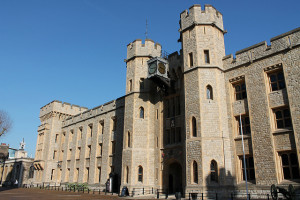
The Precious stone House and the Crown Jewels of England
Over the past centuries the Belfry of London has stored the crowns, robes, jewels and other valuable items which were worn by the kings and queens of England. The tradition of the monarch'south coronation ceremony has been performed for over 1,000 years but the coronation regalia, known collectively as the Crown Jewels, are relatively modern pieces. Several buildings throughout the Tower of London have held these items for safekeeping and in 1665 the Crown Jewels were first put on display for the public to view.
The electric current Precious stone Firm was built in 1967 as the west wing of the Waterloo Barracks. The Crown Jewels were displayed in a secured surface area in the basement of the building with the other royal items, such as the goldplate serving pieces, were displayed on an upper floor. Over time the loftier visitor omnipresence to the Jewel House in Tower of London required a larger area. Construction on the new Jewel House began in 1992 and was completed two years later in 1994. The new Jewel House was three times larger than the old ane and could conform the big crowds more than efficiently. New advanced security and brandish technology were also incorporated into the design, such every bit two inch thick shatter proof drinking glass, filtered air and fiber-optic lighting were used in the construction of the display cases.
TRAVEL TIP: Before entering the Jewel House, be sure to take a photo in front with the Tower Baby-sit lookout man post, it makes a slap-up souvenir of a mean solar day at the Tower of London!
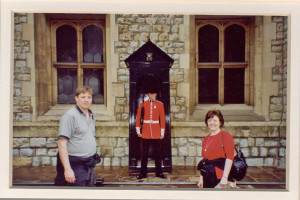
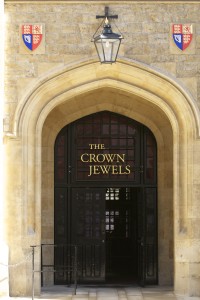 Upon entering the Jewel House, the outset area visitors will run into is called the Hall of Monarchs. On display in this room are the crests and seals, also known as the coat of artillery, of the British monarchs from William the Conqueror to the virtually recent, Queen Elizabeth II. It is a wonderful adventure to compare both the similar and sometimes unlike elements used by the various monarchs during the past centuries.
Upon entering the Jewel House, the outset area visitors will run into is called the Hall of Monarchs. On display in this room are the crests and seals, also known as the coat of artillery, of the British monarchs from William the Conqueror to the virtually recent, Queen Elizabeth II. It is a wonderful adventure to compare both the similar and sometimes unlike elements used by the various monarchs during the past centuries.
As visitors proceed through the edifice, 3 short films are shown in adjoining areas. One of those films is of the 1953 coronation ceremony of Queen Elizabeth 2; it was the first time the solemn coronation ceremony was shown on television. Take a moment to stop and run into the very young Queen being crowned but more than importantly take note of the coronation regalia that visitors volition see subsequently on their tour of the Precious stone Firm. (For more than detailed information about the 1953 coronation ceremony, please click on the following mail service called the Coronation of Queen Elizabeth II)
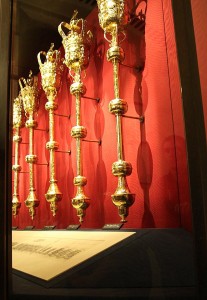 The adjacent area in the Jewel Firm is a long hallway called the Processional Style; this is where the royal maces are displayed. The mace was originally a medieval weapon made of wood and metal but over fourth dimension it became a symbol of the king or queen's rank and say-so. The more ornate ceremonial maces were fabricated of precious metal and studded with jewels to reflect the sovereign'due south high rank and is ordinarily held by someone who precedes the king or queen in a procession.
The adjacent area in the Jewel Firm is a long hallway called the Processional Style; this is where the royal maces are displayed. The mace was originally a medieval weapon made of wood and metal but over fourth dimension it became a symbol of the king or queen's rank and say-so. The more ornate ceremonial maces were fabricated of precious metal and studded with jewels to reflect the sovereign'due south high rank and is ordinarily held by someone who precedes the king or queen in a procession.
Next, is the room displaying the Crown Jewels of England and ii slow moving walkways are located on either side running the length of the display cases of the various crowns of the Kings and Queens of England. Don't worry if yous missed anything in the display cases or want a different view of the crowns, merely take the moving walkway on the other side for another expect! Be certain to expect for the Imperial State Crown worn by the Queen annually at the State Opening of Parliament, the small Queen Victoria Diamond Crown, and the Queen Mother Crown with the big 105.half dozen carat Koh-i-Nor diamond. (For more detailed information well-nigh the crowns in the collection, delight click on the following post called the Crown Jewels of England – Office Ii)
In the next room, the Coronation Regalia is on display including the coronation robe worn by the current queen, Queen Elizabeth Ii. Later the execution of King Charles I in 1649, Oliver Cromwell had the original crown jewels either sold or melted down to be made into coins. Afterwards later on the Restoration, with the loss or devastation of the crown jewels, some would say that Male monarch Charles 2 was "a king with no crown" and a new set of coronation regalia was made for him in 1661. More than half of the items on display in this room date back to that time in history, please sure to look for the Coronation Spoon which is the oldest item in the collection and is believed to be the merely item that survived the devastation of the crown jewels by Oliver Cromwell. Some other item to look for is the Sceptre with Cross with the very large 530.2 carat Cullinan I diamond which was added to the sceptre in 1910, it is the largest cut diamond in the world.
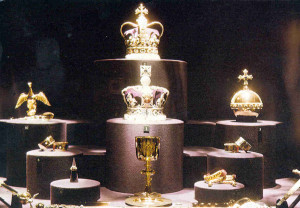
The terminal room on the Gem House bout holds the royal plate collection which is a drove of serving pieces used by the king or queen for special occasions. Look for the largest item in the collection, the beautifully decorated argent gilt 1000 Dial Bowl made in 1830, it is weighs 546 pounds and information technology was originally intended to be a vino vessel that would concord 144 bottles of wine. One of the most unique items in the collection is the Common salt of State which was made after the Restoration in 1660, the part of the piece is to concord a variety of spices for a banquet but in looks like a golden fairytale castle.
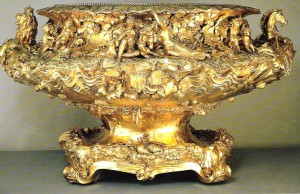
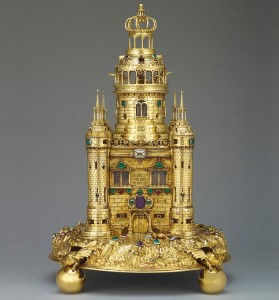
The legend of the Tower of London Ravens
Over the centuries, wild ravens were very mutual throughout United kingdom and the area of the Tower of London was inside their range. The ravens were thought to frequent the Tower supposedly attracted by the smell of the corpses of the executed enemies of the Crown the ravens would feed on the remains. Unfortunately, with the growth of the urban center London and the surrounding countryside, over time the numbers of ravens dramatically decreased.
The legend of the Tower of London ravens can be traced to the reign of King Charles 2. It seems that the flying of the ravens was start to interfere with work of the royal astronomer, John Flamsteed, who conducted his daily observations with a telescope located in the observatory of the White Tower. Male monarch Charles, who profoundly disliked the ravens' droppings on the Tower grounds, originally ordered that the ravens would be killed only he was brash that information technology was unlucky to kill a raven and if this order was carried out "the Tower would fall and he would lose his kingdom". Ever the pragmatist, Male monarch Charles sent out a new club to solve the trouble and the Purple Observatory was moved to Greenwich and the ravens' wings would be clipped to keep them at the Tower. Over the centuries, the convict ravens became associated with the tradition and superstition that as long equally in that location were ravens held at the Tower of London "the Crown will not neglect and Britain volition remain strong".
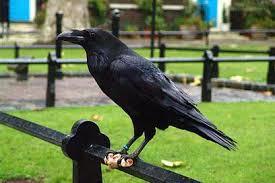 Currently the group of ravens held captive at the Tower consistently numbers a total of 7 Common Ravens. At some time over the centuries, six was determined the lucky number of ravens, and so there are six ravens that roam the Belfry grounds and an additional raven is held every bit an extra. The ravens can simply fly a very short altitude because the flight feathers on one of their wings are clipped to prevent them from leaving the Tower grounds. To identify the individual birds, each raven is marked with a different colored ring on their leg and they are besides given a name by their Yeoman Warders caretakers.
Currently the group of ravens held captive at the Tower consistently numbers a total of 7 Common Ravens. At some time over the centuries, six was determined the lucky number of ravens, and so there are six ravens that roam the Belfry grounds and an additional raven is held every bit an extra. The ravens can simply fly a very short altitude because the flight feathers on one of their wings are clipped to prevent them from leaving the Tower grounds. To identify the individual birds, each raven is marked with a different colored ring on their leg and they are besides given a name by their Yeoman Warders caretakers.
The nutrition of the Tower ravens includes fresh fruit, cheese and fresh meat such equally beefiness, chicken or lamb. They are besides given vitamins and other supplements, such every bit chopped boiled eggs and cod liver oil. The ravens are well-cared for as visitors volition note by the healthy weight and shining coats of the pampered Belfry ravens. The visitors are also advised not to feed the birds and are warned that the ravens will bite if they feel threatened. The ravens held in captivity at the Tower of London have recorded lifespans of over 40 years.
The Yeoman Warders of the Belfry of London
The Yeoman Warders are the formalism guardians of the Belfry of London. Once responsible for guarding the prisoners of the Tower and the British Crown Jewels, today the Yeoman Warders human action equally bout guides who have extensive cognition of the history of the Tower. Sometimes the Yeoman Warders are incorrectly referred to as the Yeoman of the Guard, which is the separate distinct group of royal bodyguards of the British monarch. The Yeoman Warders were first formed in 1485 by King Henry Seven and then later in 1509, his son King Henry VIII moved the official royal residence of the monarch from the Tower of London and the group carve up into two carve up groups. The majority of the Yeoman of the Baby-sit went with the King but a much smaller group of twelve Yeoman were retained at the Tower then it could maintain the formal condition of royal place. The principal role of the remaining Yeomen became the warder of the Tower prisoners and the proper name was inverse to Yeoman Warders to reflect their actual duties.
Currently at that place are 27 Yeoman Warders and 1 Chief Warder at the Tower of London. The requirement to become a Yeoman Warder is they must be a retired fellow member of the Armed Forces of England or the Commonwealth, a former senior non-commissioned officer or petty officeholder with at least 22 years of service and also hold the Long Service and Good Conduct medal. In 2007, this ordinarily male dominated institution changed and the first female Yeoman Warder, Moira Cameron, was sworn in. More changes where to come for Yeoman Warder requirements and until very recently only not-commissioned officers from the Regular army, Purple Marines and Majestic Air Force were eligible to employ for the position. The Royal Navy had been exempt because they took an oath to the Admiralty and not the Queen. In 2011, this allegiance adjuration reverted back to the Queen and the showtime Naval Yeoman Warder had practical, was accepted and sworn in. The Yeoman Warders and their families are required to live within the Tower of London and some of the housing dates back to the 13th century. The Tower has its own community with a Resident Governor, clergyman, doctor and even a pub. The only problem is that when the Tower is locked at night to keep out intruders, the Yeoman Warders and their families are locked in and are prevented from leaving the Tower until morning.
The Yeoman Warders unremarkably wears a dark bluish uniform with cherry trimmings. For official state occasions, such as the Queen visit to the Belfry, they habiliment a red and gold uniform which is very like to the Yeoman of the Guard. This compatible is referred to as the Tudor State Apparel which has changed very little from when information technology was in the 1400s and it is very uncomfortable to wear because of the high white collar and heavy fabric.
The Yeoman Warders are sometimes called "Beefeaters" which has a historical origin as the Yeoman from centuries past were given the right to consume every bit much beef as they wanted at the Rex's table and basically the Yeoman were a very well feed grouping! Simply according the modern-solar day Yeoman Warder in charge as the Ravenmaster, it is the Tower Raven that are the real "beef-eaters" because of their daily diet of meat!
T he Anniversary of the Keys
A long standing tradition is the Ceremony of the Keys which is held every night at the Tower of London and information technology has been performed in the same mode since the xivth century. The Chief Yeoman Warder, who is dressed in Tudor watchcoat, meets his armed forces escort of Tower of London Guards at exactly nine:53 p.m. Together they will march to lock the principal gates of the Tower. After securing the Tower Gate, the Primary Yeoman Warder with his military escort will march down Water Lane. On the manner dorsum into the Tower, the group is stopped by a sentry that shouts, "Halt! Who goes there?" The Yeoman Chief Warder replies, "The keys" "Who's Keys", the scout says. "Queen Elizabeth's keys" the Chief Warder answers back. The sentinel states, "All is well" and allows the group to pass.
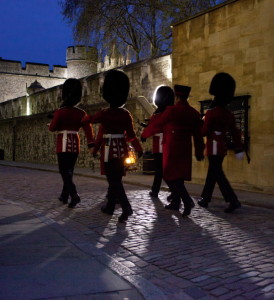
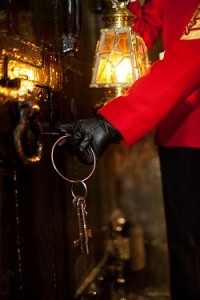
The Yeoman Chief Warder and his armed forces escort proceed through the Encarmine Tower Entrance and into the chief area of the Tower. The grouping halts at the bottom of a set of stairs known as the Broadwalk Steps. At the superlative of the stairs some other group of Belfry Guards are chosen to present arms (a armed forces command shown as a sign of respect). The Principal Warder raises his hat and calls out, "God save Queen Elizabeth". The ceremony is ended when the Chief Warder takes the keys to the residential section of the Tower to a building known equally the Queen's Business firm and the keys are stored for safekeeping while the Concluding Postal service is sounded for the night which officially ends the 24-hour interval at the Tower of London.
TRAVEL NOTE: When visiting the Tower of London, I would definitely recommend the free 1 60 minutes tour given by a Yeoman Warder guide. These tours are an excellent way to larn the history of the Belfry, only they are as well surprising entertaining and humorous despite the serious topics of imprisonment, execution and torture.
For more information, such every bit hours of operation and access cost for the Tower of London, delight see their website at world wide web.hrp.org.uk/TowerOfLondon
vanleuvenwaallovar.blogspot.com
Source: https://theenchantedmanor.com/tag/the-tower-of-london-ceremony-of-the-keys/
Post a Comment for "Ceremony of the Keys Beef at Kings Table"